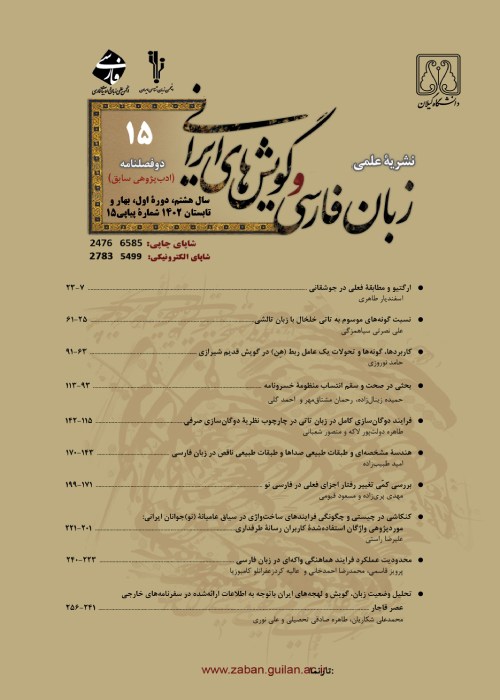The Judeo-Persian letter of Dandān-Uiliq II
This paper deals with a Judeo-Persian letter named Dandān-Uiliq II (henceforth DU II); which probably dates back to 9th century C.E. In addition to its content, DU II has some important linguistic features, often absent in Persian texts written in Arabic script. Among them the use of “kū” as a preposition and the ancient subjunctive mood can be mentioned. The present paper will present a translation of the letter in addition to a discussion of its ancient linguistic features with comparison to the Early New Persian texts (in Perso-Arabic script) and certain early Quran translations into Persian (especially Qur'an-e Quds). The linguistic features of this early Judeo-Persian letter will represent a definite stage where the language is changing from Middle Persian to New Persian (Dari). Since the evidences related to this stage is relatively rare in the extant texts of Persian, this letter can undoubtedly be used for a more understanding of the period of Persian language evolution. The given translation is not the same as the previous English and Chinese translations and reflects our understanding of its syntax and morphology.
Iranian Jewish communities have not settled only in the borders of Iran today, but in neighboring countries. Their works, including unwritten as well as written materials, are not only the best heritages of their presence but also the mirror of Iranian culture, language and daily matters. Their value in a time when the works and materials reflecting the Iranian culture are not so numerous, and especially regarding the language, when most of the works are written in Arabic or at least in an official form of the Persian not reflecting the local changes as well as the process of transmission of the Middle Persian to the Early New Persian becomes more understandable. In such an environment and in a multicultural district like the Taklamakan, two Judeo-Persian letters written by ink on the papers have been found till now. In addition to their information about the district in the 8th-9th century C.E., the letters show a kind of local dialect which in companion with other few documents from this period, can give the researchers of the Persian language, some samples showing how the Middle Persian have been transmitted to the Early New Persian. In Dandān-Uiliq, the writer after greetings, starts to count the gifts and the materials he has sent or has given to some officials there. In the last part, he advises that they should behave in a friendly manner towards the daughter of Dihqan and also gives some reports on the war and peace in Kashgar with Tibetans. The letter is not complete and the end part has missed.
The theoretical framework of the present paper is based on the common method of the Judeo-Persian studies and Persian language and literature as well as the historical linguistics.
In this paper, by discussing the previous works on DU II as well as other EJP related texts, the authors tried to find all the available researches, and then by processing the information, emended previous researches and in some cases, they have strengthened and expanded such information. It’s noteworthy that everywhere they have found some ambiguities, did their best to make them clear.
The Judeo-Persian letter of DU II represents some important linguistic features, often in the absence of Persian texts written in Arabic script, e.g. the use of kū as a preposition and the ancient subjunctive mood. The letter has been translated in this paper and its ancient linguistic features have been discussed with comparison to the Early New Persian texts (in Perso-Arabic script) and some early Qur'an translations into Persian (especially Qur'an-e Quds). These features represent language transmission from Middle Persian to New Persian (Dari). The given translation is not the same as the previous English and Chinese translations and reflects our understanding of its syntax and morphology.
The Judeo-Persian letter of DU II which is written approximately in the 9th century in the oasis of Dandān-Uiliq is the second letter of its kind and shows the historical, cultural, financial as well as the political and linguistic environment of the district at the time. From a linguistic point of view, the letter asserts the previous findings, however, it portrays some new features as well.
- حق عضویت دریافتی صرف حمایت از نشریات عضو و نگهداری، تکمیل و توسعه مگیران میشود.
- پرداخت حق اشتراک و دانلود مقالات اجازه بازنشر آن در سایر رسانههای چاپی و دیجیتال را به کاربر نمیدهد.


